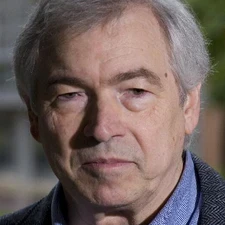James R. Rice

The 2012 Louis Néel Medal is awarded to James R. Rice for his seminal contributions to our fundamental understanding of strain localization, poromechanics and friction and his elegant and systematic studies have elucidated fault mechanics and the coupling with hydrologic and thermal processes during all phases of the earthquake cycle.
James R. Rice is an outstanding and internationally leading scientist in the fields of solid mechanics, rock physics and mechanics of earthquakes. Widely recognized as the world’s leading researcher in solid mechanics over the last four decades, he is probably unique in having contributed so broadly not only in engineering, but also in geosciences. Rice’s early contributions in the areas of solid mechanics and materials science include the theory of crack propagation in elastic-plastic material, mechanics of void formation and ductile fracture, as well as formulation of inelastic constitutive relations. His invention of the path-independent J-integral forms the basis for the practical application of nonlinear fracture mechanics to the development of standards for the safety of structures. Since the 1970s, Rice has shifted his research interest to also focus on fundamental mechanics problems that arise in seismology, tectonophysics and geomechanics. In rock physics, he and students have made seminal contributions in the mechanics of strain localization, poroelasticity and the coupling of deformation and fluid flow, as well as constitutive modeling of rock friction and instability. A unified framework for the analysis of strain localization in geomaterials was presented by Rudnicki and Rice, who treated the initiation of localized deformation as a bifurcation from homogeneous deformation and showed that its onset was promoted by certain subtle features of the constitutive behaviour. In linear poroelasticity Rice and Cleary presented an insightful formulation of the equations first derived by Biot, which has proven so advantageous that it is now the standard form adopted in geophysics. The models of earthquake instability formulated to study these effects were among the first in which the instability was not postulated but arose in a mechanically consistent way from the interaction of the fault zone material behaviour and the surroundings. Based on experimental observations of Jim Dieterich, Rice and his student Andy Ruina formulated the rate- and state-dependent constitutive model for frictional sliding, which can capture the full spectrum of nonlinear dynamical behaviours observed in rock friction experiments. For over two decades this constitutive framework has had significant impact on the mechanical analysis of all aspects of the earthquake cycle. Rice’s seismological studies have elucidated the mechanics of the nucleation of rupture, thermo- and hydro-mechanical weakening of fault zones during seismic slip, slip patterns and complexity, postseismic deformation and aseismic creep, fracture propagation through branched and offset fault systems, as well as glacial earthquakes. Among his colleagues, Rice is known to have some of the highest standards of scholarship and intellectual honesty. He is always ready to appreciate the good work of other colleagues, and to give them proper credit. He has mentored numerous doctoral and postdoctoral fellows, who have gone on to establish outstanding careers in the academia and industry worldwide. For his contributions to geosciences and engineering, Rice has received numerous awards and recognitions by professional societies and academic institutions. Over the years he has maintained active and productive collaborations with many institutions in Europe. He is a Foreign Member of the Royal Society of London, and the Académie des Sciences, Institut de France. This represents an outstanding body of achievement and Rice therefore richly deserves the Néel Medal and the high honour that it represents.
